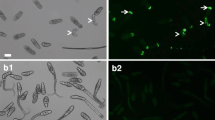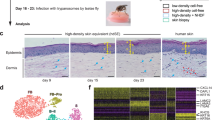Abstract
We studied the skin invasion of Schistosoma mansoni cercariae by placing gamma-irradiated and nonirradiated cercariae onto the living human skin and timing the behavior of 53 individuals. The skin invasion of S. mansoni was less efficient compared to the bird schistosome Trichobilharzia szidati. S. mansoni cercariae crept longer on the skin after attachment until they started penetration movements (median of 43 s [range of 15 s–6.58 min]; T. szidati, median of 8 s [range of 0–80 s]). Subsequent to this longer exploratory phase, 74% penetrated into wrinkles (T. szidati 84%), 22% into the smooth skin surface (T. szidati 0%), and 4% into hair follicles (T. szidati 16%). The S. mansoni cercariae needed, on average, 6.58 min (range of 1.57–13.13 min) for full entry, while T. szidati needed 4.0 min (range of 1.38–13.34 min); the fastest S. mansoni cercaria entered the skin within 94 s, while T. szidati entered within 83 s. Sixty percent of the S. mansoni cercariae had the tails still attached when the bodies disappeared in the skin whereas all T. szidati cercariae shed their tails within 0–105 s after the onset of penetration movements. The faster invasion of T. szidati may result from the more sophisticated host-finding mechanisms of this species. Regarding S. mansoni, cercarial dermatitis, as immediate skin response, developed after a sensitization period of 19 days.


Similar content being viewed by others
References
Bartlett A, Brown M, Marriott C, Whitfield PJ (2000) The infection of human skin by schistosome cercariae: studies using Franz cells. Parasitology 121:49–54
Brachs S, Haas W (2008) Swimming behaviour of Schistosoma mansoni cercariae: responses to irradiance changes and skin attractants. Parasitol Res 102:685–690
Coulson P (1997) The radiation-attenuated vaccine against schistosomes in animal models: paradigm for a human vaccine? Adv Parasitol 39:271–336
Dvorák J, Mashiyama ST, Braschi S, Sajid M, Knudsen GM, Hansell E, Lim K-C, Hsieh I, Bahgat M, Mackenzie B, Medzihradszky KF, Babbitt PC, Caffrey CR, McKerrow JH (2008) Differential use of protease families for invasion by schistosome cercariae. Biochimie 90:345–358
Feiler W, Haas W (1988a) Host-finding in Trichobilharzia ocellata cercariae: swimming and attachment to the host. Parasitology 96:493–505
Feiler W, Haas W (1988b) Trichobilharzia ocellata: chemical stimuli of duck skin for cercarial attachment. Parasitology 96:507–517
Grabe K, Haas W (2004) Navigation within host tissues: Schistosoma mansoni and Trichobilharzia ocellata schistosomula respond to chemical gradients. Int J Parasitol 34:927–934
Haas W (1976) Die Anheftung (Fixation) der Cercarie von Schistosoma mansoni. Einfluss natürlicher Substrate und der Temperatur. Z Parasitenkd 49:63–72
Haas W (2003) Parasitic worms: strategies of host finding, recognition and invasion. Zoology 106:349–364
Haas W, Haberl B (1997) Host recognition by trematode miracidia and cercariae. In: Fried B, Graczyk TK (eds) Advances in trematode biology. CRC, Boca Raton, pp 197–227
Haas W, Schmitt R (1982a) Characterization of chemical stimuli for the penetration of Schistosoma mansoni cercariae. I. Effective substances, host specificity. Z Parasitenkd 66:293–307
Haas W, Schmitt R (1982b) Characterization of chemical stimuli for the penetration of Schistosoma mansoni cercariae. II. Conditions and mode of action. Z Parasitenkd 66:309–319
Haas W, van de Roemer A (1998) Invasion of the vertebrate skin by cercariae of Trichobilharzia ocellata: penetration processes and stimulating cues. Parasitol Res 84:787–795
Haas W, Granzer M, Garcia EG (1987) Host identification by Schistosoma japonicum cercariae. J Parasitol 73:568–577
Haas W, Haberl B, Schmalfuss G, Khayyal MT (1994) Schistosoma haematobium cercarial host-finding and host-recognition differs from that of S. mansoni. J Parasitol 80:345–353
Haas W, Diekhoff D, Koch K, Schmalfuss G, Loy C (1997) Schistosoma mansoni cercariae: stimulation of acetabular gland secretion is adapted to the chemical composition of mammalian skin. J Parasitol 83:1079–1085
Haas W, Grabe K, Geis C, Päch T, Stoll K, Fuchs M, Haberl B, Loy C (2002) Recognition and invasion of human skin by Schistosoma mansoni cercariae: the key-role of L-arginine. Parasitology 124:153–167
Haeberlein S, Haas W (2008) Chemical attractants of human skin for swimming Schistosoma mansoni cercariae. Parasitol Res 102:657–662
Horák P, KoláÍová L, Adema CM (2002) Biology of the schistosome genus Trichobilharzia. Adv Parasitol 52:155–233
Kasny M, Mikes L, Dalton JP, Mountford AP, Horak P (2007) Comparison of cysteine peptidase activities in Trichobilharzia regenti and Schistosoma mansoni cercariae. Parasitology 134:1599–1609
Kock S (2001) Investigations on intermediate host specificity help to elucidate the taxonomic status of Trichobilharzia ocellata (Digenea: Schistosomatidae). Parasitology 123:67–70
Mikes L, Zidkova L, Kasny M, Dvorak J, Horak P (2005) In vitro stimulation of penetration gland emptying by Trichobilharzia szidati and T. regenti (Schistosomatidae) cercariae. Quantitative collection and partial characterization of the products. Parasitol Res 96:230–241
Odening K (1996) What Cercaria ocellata actually is. In: Özcel MA (ed) New dimensions in parasitology. Acta Parasitologica Turcica (Suppl 1):387–397
Pan C, Williams RR, Ritchie LS (1954) The penetration-time for the cercariae of Schistosoma japonicum. Am J Trop Med Hyg 3:136–138
Riengrojpitak S, Anderson S, Wilson RA (1998) Induction of immunity to Schistosoma mansoni: interaction of schistosomula with accessory leucocytes in murine skin and draining lymph nodes. Parasitology 117:301–309
Rudolfová J, Hampl V, Bayssade-Dufour C, Lockyer AE, Littlewood DTJ, Horák P (2005) Validity reassessment of Trichobilharzia species using Lymnaea stagnalis as the intermediate host. Parasitol Res 95:79–89
Ruppel A, Chlichlia K, Bahgat M (2004) Invasion by schistosome cercariae: neglected aspects in Schistosoma japonicum. Trends Parasitol 20:397–400
Salter JP, Lim K-C, Hansell E, Hsieh I, McKerrow JH (2000) Schistosome invasion of human skin and degradation of dermal elastin are mediated by a single serine protease. J Biol Chem 275:38667–38673
Salter JP, Choe Y, Albrecht H, Franklin C, Lim K-C, Craik CS, McKerrow JH (2002) Cercarial elastase is encoded by a functionally conserved gene family across multiple species of schistosomes. J Biol Chem 277:24618–24624
Stirewalt MA, Hackey JR (1956) Penetration of host skin by cercariae of Schistosoma mansoni. I. Observed entry into skin of mouse, hamster, rat, monkey and man. J Parasitol 42:565–580
Wang L, Li Y-L, Fishelson Z, Kusel JR, Ruppel A (2005) Schistosoma japonicum migration through mouse skin compared histologically and immunologically with S. mansoni. Parasitol Res 95:218–223
Whitfield PJ, Bartlett A, Khammo N, Brain APR, Brown MB, Marriott C, Clothier R (2003) Delayed tail loss during the invasion of human skin by schistosome cercariae. Parasitology 126:135–140
Wulff C, Haeberlein S, Haas W (2007) Cream formulations protecting against cercarial dermatitis by Trichobilharzia. Parasitol Res 101:91–97
Acknowledgements
This work was supported by the Deutsche Forschungsgemeinschaft. We thank Professor Reinhold Müller, Strahlenklinik, Universitätsklinikum Erlangen for gamma-irradiation of the cercariae and Christina Loy for her expert technical work. The experiments comply with the current laws of Germany.
Author information
Authors and Affiliations
Corresponding author
Rights and permissions
About this article
Cite this article
Haas, W., Haeberlein, S. Penetration of cercariae into the living human skin: Schistosoma mansoni vs. Trichobilharzia szidati . Parasitol Res 105, 1061–1066 (2009). https://doi.org/10.1007/s00436-009-1516-8
Received:
Accepted:
Published:
Issue Date:
DOI: https://doi.org/10.1007/s00436-009-1516-8




